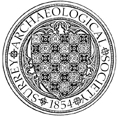Talk by David Staveley: Finding Roman roads
David Staveley is well known to many of us in RSG. He is a computer programmer by day and in his spare time is an archaeological geophysicist studying Roman roads and roadside settlements in Sussex. David has carried out ground penetrating radar at Flexford and has used GPR to identify Stane Street beneath Church Street in Ewell (in conjunction with the Church Meadow Project). He is also the author of Snuffler, freeware geophysics software for earth resistance and magnetometry.


